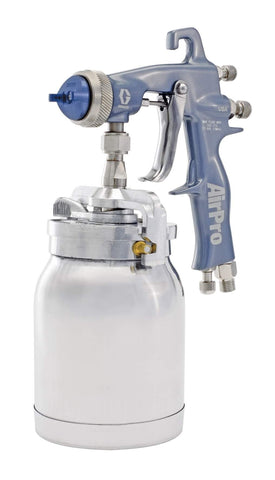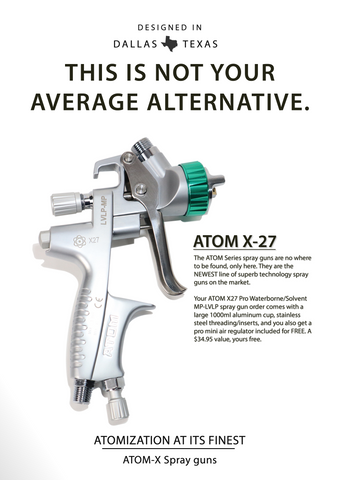Automotive Spray Gun Selection Tips For DIY And Professionals - HVLP or LVLP Spray Guns?
Which spray gun is right for your specific application, a HVLP, or a LVLP?
First let's talk about the three types of spray guns that are mainly manufactured for automotive, and woodwork refinishing.
The first one is a conventional style siphon feed spray gun (with the paint cup at the bottom of the gun). This type of gun is an older design for automotive use, but is still used for some industrial applications today.
30 years ago, siphon spray guns were very popular in automotive body repair shops. Some people still use them today, but in general, it's a dinosaur model for most automotive refinishing applications. Conventional spray guns are inefficient, have a bad transfer rate (only 35%), waste a lot of paint material, and create a lot of overspray.

The second and third type of spray gun, the type you want is the gravity feed HVLP, or LVLP spray gun. The Atom X calls theirs the MP-LVLP because it's more of a hybrid low-volume low-pressure and medium-pressure spray gun which makes it very unique compared to other spray guns on the market.
The HVLP gravity feed spray gun is the most efficient and popular type of spray gun today. It does not need compressed air to feed material to the fluid nozzle, and therefore it uses less cap pressure (about 10psi at the cap) to spray and atomize the paint material.
As shown below, the Atom X27 HVLP paint cup is located at the top of the spray gun and the paint feeds into the gun body through the force of gravity.
It looks like this:

High-Volume Low-Pressure (HVLP) spray gun.
What is HVLP?
HVLP spray guns deliver the paint material to the car at pressures of approximately 10 psi at the air cap. Because of environmental concerns, the HVLP gun is now required in most areas, and in body shops across the U.S.
When using High-Volume Low-Pressure spray guns, there is considerably less overspray, so they offer the added advantage of material savings.
To be used for surface coating application, all spray guns must have at least 65% transfer efficiency, which means that at least 65% of the material being sprayed is applied to the panel that is being painted.
This is one area where ATOM X shines. Through hours of research and testing, transfer rate of the ATOM X can reach up to 76%. Of course this will depend on the material being sprayed and your spray gun settings.
Watch the video as Tony explains HVLP spray guns in detail.
Low-Volume Low-Pressure Spray Gun (Atom X MP-LVLP).
What is LVLP?:
Low-Volume Low-Pressure, means exactly that. It uses less air volume pressure to function. This type of spray gun is not only recommended for users who have a smaller air compressor with less volume, but it's an ideal type of spray gun for spraying clearcoats. This spray gun is perfect for DIY'ers and Professionals.
Watch the video below where Tony explains LVLP spray guns.
Air Cap/ Tip Selection Tips: A 1.3 and 1.4 tip is the perfect size for all around automotive and woodwork refinish work.
It's really user preference.
Tony uses a 1.4 for most of his basecoat and clearcoat painting. When it comes to spraying thicker primers and filler/primers, ideally you'd want to use a bigger tip size for the thicker material to flow out better.
If you use the 1.3 or 1.4 when spraying primers, you'll notice that the spray gun will strain when spraying. This is because the thicker viscosity of the primer. You need a bigger orifice for better material flow. You'll also notice very dry spraying and sand like texture on your panel. The 1.8, or 2.0 tip kits are best for primer/filler spraying.
Although there is a way to successfully use a 1.3, or 1.4 when spraying primers, as Tony says, just thin out your primer 10-20%. The down side is that you'll need to spray more coats to get a fill, and you won't be spraying and laying on the material as recommended.
If you can and have the budget to, it would be wise to just pick up a tip kit for your specific spray gun that will allow you to spray thicker primer materials the proper way.
The great thing about Atom X spray guns is the affordable cost of extra tip kits. Most high end spray gun companies charge you an arm and a leg for fluid tips, and air caps. You could end up paying as much as $300.00 for a complete tip kit from SATA.
Atom's tip kits are a complete and can be swapped out in 30 seconds flat. You get the fluid tip, air cap, nozzle, and needle in one package, and pricing varies from $50-$80 depending on where you shop. See sample Atom Tip Kit Here.
Here is one more video where Tony breaks down both HVLP and LVLP spray guns. Enjoy and please comment below!
HVLP or LVLP Spray Gun Talk:
Hope you enjoyed this article and videos 😃👍
Shop ATOM X Spray Guns Here!
Learn more about DIY auto body here and how to get amazing professional finishes from your home or shop without $900.00 spray guns, or a professional spray booth!
-The ZooLaa Genie

Ya I’m also new to the game, and wondering what the differences are between the X27, X21 and the X20? I’m sure they are all great guns. As of right now I spray on small projects like Helmets, and metal panels, but here now I’m prepping my own truck and wanting to paint it myself, so I want a spray guns for that. But also want to know what is best for the smaller projects?
Great video, clearly explained. I have three classic French sports cars I am restoring and will be spraying them myself. I have body repair and spraying experience from years ago but was unsure of the best modern spray gun for my needs. Thanks to this very professional video I can now make an informed decision I will be confident in. Thanks Tony, you have been a great help.
When spraying a 2k primer filler do you take out the filter in the gun ?
Hi Tony;
I have been painting motorcycles for man y years with good results… by this I mean gas tanks, body panels, headlight shells, fenders, etc. The good news is that my parts are usually hanging and I can also use my free hand to hold the part at the best desired angle. for these small jobs I have been using a small “detail” gun that only holds about 8 oz of material, and is a “siphon style”. For now almost all of my spraying has been onto VERTICAL surfaces. So my question is how to paint onto horizontal surfaces like the hood or roof of a car? You showed a side mount gun that made sense to me as it looks like you can “turn the reservoir” to remain more or less vertical even as the gun is pointing downward. But how do you do this on a fixed reservoir gun like the Atom guns? Is this even a big deal? Thanks, Victor
hi Tony,
i would like to know how i can recognize a HVLP and a LVLP gun when they are put together. is written somewhere on the gun or by its design. could you help me please? thank you.